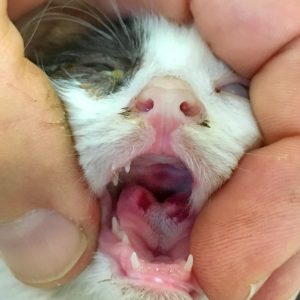Updated November 28, 2020
What do the diseases we protect your cat from actually look like?
Click here to see vaccination protocols for cats or continue reading to learn about these important illnesses.
Cat Flu
Cat Flu is really two similar but different diseases, caused by a herpesvirus and a calicivirus. Both viruses cause a fever, loss of appetite, ulceration of the mouth and a severe upper respiratory infection.
Kittens are more severely affected and can have other signs such as stillbirth, stunted growth, arthritis or pneumonia. These unusual cat flu cases are tragically hard to treat.
More information about cat flu and other causes of mouth ulcers can be found by following the links.
How common is cat flu?
Cat flu is widespread in cats in Adelaide, especially wherever cats are held together in groups.
Why is cat flu such a problem?
- Like most cat viruses, they aren’t only spread by sick animals, but also by healthy carriers.
- Calicivirus is highly resistant to disinfection.
- Virus can be spread on hands, clothes, rubbing posts and bowls.
- Stray urban cats also spread the disease.
Feline Enteritis
Also called panleucopaenia , feline enteritis is actually a parvovirus. Just like in dogs, it causes severe vomiting, diarrhoea and rapid death, and is a virus which survives for a long time in the environment.
How common is feline enteritis?
These days we hardly see it, but before vaccination whole cat groups (such as on farms) could die so quickly the farmers thought they had been poisoned. It’s been in the news recently from shelters in Victoria but only in cats without vaccination.
Feline Acquired Immunodeficiency
Feline Immunodeficiency Virus is a virus related to HIV which causes an AIDS-like syndrome in cats. Cats get the virus after being bitten by an infected cat. Initially they get a minor fever and recover, but the virus stays in their system. Later it causes their immune system to work less and less well until minor infections can spread uncontrollably.
Click here for more about the signs, tests, treatment and prognosis of FIV.
How common is FIV infection?
When the vaccine was released we tested most adult cats before starting the vaccine. We found that 10% of cats with outside access were carrying the virus. In the years since, these cats were more likely to develop unusual and severe infections, and generally had reduced lifespans.
Prevention of Cat Flu and Feline Enteritis
- The first vaccination with the breeder is a temporary vaccine and is not protective on its own.
- Get your kitten vaccinated as soon as possible, and follow your vet’s cat vaccination schedule. Take note of when your vet advises you their vaccine will start being protective.
- Until this date, keep your kitten isolated and especially avoid cat boarding.
- Due to the presence of healthy carriers, be careful exposing your kitten to any other cat until fully vaccinated. Virus can also be transmitted by dirt, hands, shoes, clothing, bowls, bedding, playthings etc that have been in contact with other cats.
- Avoid contact with sick cats. If you have been in contact with a sick cat, dispose of your clothing, and keep the kitten away from yourself, and the infected environment until the kitten is fully protected. Do not rely on disinfectants.
- If you keep your cat’s vaccinations up to date, there is very little chance of these diseases causing him or her a problem.
Prevention of FIV
- FIV is only spread by transmission of bodily fluids. In cats, the main form of spread is via a deep bite from another cat.
- If you cannot confine your cat or enclose their outside area, you can still reduce the number and severity of fights by only letting them outside during daylight hours.
- There is a good vaccine available.
There are a lot more important diseases you can stop your cat from experiencing. Click on the links to learn more about the parasitic diseases such as heartworm and intestinal worms.
Have something to add? Comments (if open) will appear within 24 hours.
By Andrew Spanner BVSc(Hons) MVetStud, a vet in Adelaide, Australia. Meet his team here.


Hello dr Andrew
I have a new cat who has been diagnosed with FIV and a cat who is a carrier for cat flu (no active infection for 2 years)
Both are rescue cats and live in different parts of the household.
I wonder if now having the fiv diagnosis i need to surrender one of the cats due to the risk to the fiv cat?
It breaks my heart thinking about it hence looking for a professional opinion
Hi Joanna. It’s a good question. While I am unable to provide a guarantee, generally FIV does not cause the level of immunosuppression that leads to failure of cat flu vaccines. We find that as long as FIV positive cats have up to date vaccinations, they can live with flu carriers without a problem.